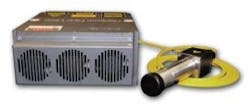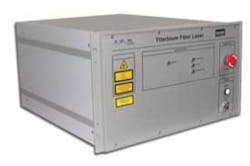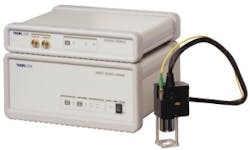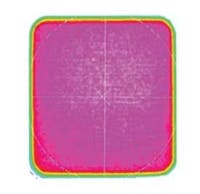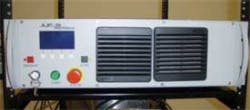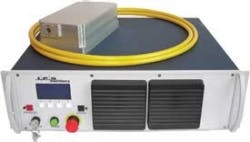Developments in fiber laser technology
Tony Hoult
FIBER LASERS CONTINUE TO EVOLVE WITH A WIDE RANGE OF POWER AND APPLICATIONS
Fiber lasers are fundamentally different from other laser types; in a fiber laser the active medium that generates the laser beam is actually dispersed within the fiber optic itself. This differentiates them from fiber-delivered lasers where the beam is simply transported from the laser resonator to the beam delivery optics. Fiber lasers are now widely accepted as being the most focusable (or highest brightness) of any laser type.
Fiber lasers have consolidated their position at the high average power multi-kilowatt end of the industrial laser spectrum and it is clear that the limitations associated with fiber lasers earlier are now well understood, allowing the development of a wide range of lasers. The intrinsically scalable concept of fiber lasers has been used to scale multimode fiber lasers up to output powers greater than 50 kW and single mode fiber lasers up to 10kW in power.
Pulsed fiber lasers
Pulsed nanosecond lasers were, however, the earliest types to be developed and these have enjoyed commercial success, taking over a large portion of the market for general-purpose marking lasers. Average power for this type of laser has now been scaled up to 500W. Conversely, this in depth understanding of fiber laser technology has also led to fiber lasers being scaled down to low nanosecond pulse lengths, to high brightness, and to high repetition rates up to several MHz. Polarization-maintaining source lasers have also now been developed to enable efficient frequency conversion to 532 nm. Recently, quasi-continuous wave (QCW) lasers with longer pulse durations, in the millisecond regime, have been developed. The well understood benefits of fiber lasers are, therefore, available for almost the complete range of macro and micro industrial laser processing.
Nanosecond pulsed fiber lasers
There have been continuing improvements to general-purpose marking lasers and to the galvanometer-based scanner systems into which they are integrated, enhancing their capabilities. A Q-switched type fiber laser with a pulse energy capability of up to 1 mJ is capable of marking many different materials from ceramics to
High average power Q-switched fiber lasers
Further development has led to compact 500 W average power systems with sub-100 ns pulse durations. This range of lasers has an all-fiber format in a 3 stage MOPA configuration. Fiber pigtailed AOMs are used to control pulse duration that can be specified from 30 to 2000 ns to give a range of peak powers up to 1 MW. Output isolators are “fiber to air” or “fiber to processing fiber.”
MOPFA lasers
The second major group of pulsed fiber lasers, referred to as seed diode Master Oscillator Power Fiber laser (MOPFA) differentiate themselves from Q-switched type fiber lasers in that pulse rise times may be faster, pulse duration may be shorter, pulse width may be variable, and pulse repetition rate can be up to several MHz.The combination of parameters shown in Table 3 enables both marking and micromachining tasks due to greatly increased peak power and power density capability. Pulse width can be reduced down to <10ns, so achievable fluence is high. Micromachining processes where the precise removal of small volumes of material is required over limited areas can be addressed with this type of laser. Until the development of these new types of high-brightness short pulse length lasers with excellent pulse-to-pulse stability, the only solution to a particular micromachining process was often a higher cost diode-pumped solid-state laser or a far less efficient flashlamp-pumped solid-state laser.
Frequency doubled green emitting fiber lasers
Although not strictly a green fiber laser in that the active medium does not directly emit a 532 nm laser beam,FIGURE 6. 19-inch rack mounted seed diode MOPFA laser
The single-pass Second Harmonic Generator uses a 20 mm LBO crystal. A high-speed digital servo loop is employed with an active piezoelectric mirror. The high spectral brightness of the source laser enables efficient conversion, 84% conversion efficiency with >20% wallplug laser efficiency. Scalability to higher powers at 355 and 266 nm is feasible.
Continuous wave (CW) lasers - modulated
Pump diode rise times are of the order of 5 µs so minimum pulse duration (or modulation on time) is ~ 10 µs.Quasi-continuous wave (QCW) lasers
Although CW fiber lasers have been capable of achieving high energy pulses, this has been achieved by either using a higher than necessary average power or by using an excessively long pulse duration, both of these have disadvantages. The range of CW lasers has been extended recently with the development of higher peak power, high pulse energy lasers, see Table 5.
The multi-Joule pulse energy and long pulse capability of this laser combined with the ability to fit larger diameter fibers allows spot welds up to 0.5 mm diameter to be produced. Early trials have shown that these low duty cycle welds are identical in every respect to those produced by a flashlamp-pumped solid-state laser.
Fiber laser improvements
Some of the reasons that fiber lasers have moved forward so rapidly are presented below;
- In-depth science has allowed increased thermal loads in fibers without any thermal degradation or photo-darkening effects and Stimulated Raman Scattering (SRS) effects, often proposed as a limitation of fiber lasers, have been suppressed up to high average powers.
- As pump sources, single emitter pump diodes have significant reliability advantages over pumping schemes that use diode bars and stacks. Pump diode lifetimes are typically >100,000 hours and do not therefore need replacing within the lifetime of the complete laser processing system. Intensive burn-in testing has improved reliability even further.
- Increasing diode pump power and improving pump efficiency enables higher average powers.
- Fibers, by their very nature, are largely self-cooling, thus reducing thermal lensing and simplifying laser design. These benign thermal environments mean that cooling requirements are not as arduous as for other laser designs pumped by diode bars and stacks.
- Multiple fiber diameter choices with plug-and-play fibers allows for a variety of spatial energy distributions; small single mode Gaussian fibers for cutting and drilling, larger diameter multi-mode fibers for welding or surfacing processes. A CW single mode fiber laser equipped for example with a 50 µm diameter fiber can be changed from a cutting to a welding laser simply by changing the final focusing optics.
- Fiber adapters are available for up to 25 kW transmitted power. Fiber laser power beam switches for fiber-to-fiber connection with up to 6 channels and with switching times < 10 ms have been developed. Visible red aiming beams can be provided for each channel.
- Higher speed electronics, advanced interfaces, control & network software have been developed.
Developments in micromachining and marking
As we have seen there is now a variety of pulsed fiber lasers available that when combined with state-of-the-art galvanometer scanners can be used for many subtractive cutting, drilling, and ablation processes. It has been shown elsewhere that the basic material removal phenomena produced by high power density infrared laser beams apply to both laser micromachining and marking and the increasing brightness from fiber lasers means that material removal processes can be significantly enhanced. Combining this with increasing accuracy from galvanometer scanners has meant that marking lasers can now perform some processes previously thought of as precision micromachining tasks. Although wavelength is directly proportional to brightness and focusability, it has been possible in some cases to achieve the feature size, accuracy and precision that was previously only available from doubled (532nm) and tripled (355nm) lasers.
Fiber laser spot welding
Modulating single emitter pump diodes in a low to medium duty cycle regime is known to be far less problematic than modulating diode bars or stacks. The recent development of specialized pump diodes with enhanced pulsing capability has allowed high brightness fiber lasers to be developed that produce pulses closely resembling those of a conventional flashlamp pumped laser as shown in Table 5. Combining this with the ability to fit a range of fiber diameters allows this laser to produce low heat input, low duty cycle spot welds identical to those produced by a conventional flashlamp pumped laser but with all of the well-known advantages of fiber lasers, i.e. much smaller footprint, reduced maintenance and 10X wallplug efficiency. Temporal pulse shaping, identical to that used for medical device welding applications is easily achieved due to the flexibility of the pump sources that suffer from none of the limitations of conventional flashlamps.
Processing with high average power fiber lasers
Although 10 kW single mode lasers have been built, this combination of average power and brightness is clearly excessive for current materials processing requirements. There is a limitation to the achievable aspect ratio for the conventional gas assist laser cutting process imposed by the need to supply gas to the cutting front.
Fiber lasers are now widely recognized as the brightest and most highly focusable source of infrared laser beams and this, along with the other well-known benefits of fiber lasers, has led to an increasing market share in the demanding sheet metal cutting sector, especially in Europe. It is now widely accepted that for cutting of metallic materials below 8 mm thick, fiber lasers are able to produce equivalent cut quality at higher speeds using the same power or at the same speed using lower power as CO2 lasers. There has been some suggestion in the scientific literature that there is an intrinsic difference in the way these different laser wavelengths behave during the laser cutting process for > 10 mm thick steels, and clearly this is still under investigation although real improvements in cut quality are now being made by European integrators of fiber lasers for thick section cutting.
Dr. Tony Hoult ([email protected]) is with IPG Photonics, Santa Clara, CA. He is also a member of the ILS International Editorial Advisory Board.


